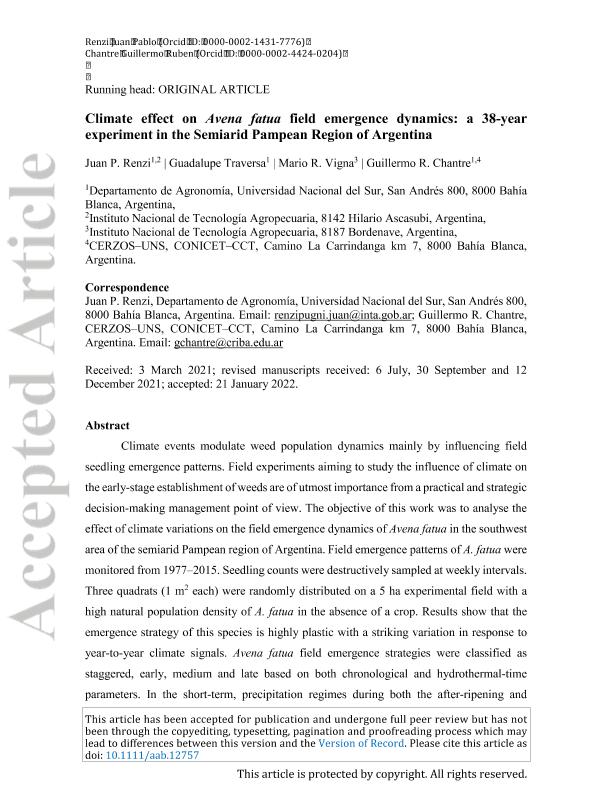Mostrar el registro sencillo del ítem
dc.contributor.author
Renzi, Juan Pablo

dc.contributor.author
Traversa, Guadalupe

dc.contributor.author
Vigna, Mario Raul

dc.contributor.author
Chantre Balacca, Guillermo Ruben

dc.date.available
2022-11-01T13:20:06Z
dc.date.issued
2022-02-13
dc.identifier.citation
Renzi, Juan Pablo; Traversa, Guadalupe; Vigna, Mario Raul; Chantre Balacca, Guillermo Ruben; Climate effect on Avena fatua field emergence dynamics: A 38-year experiment in the semiarid Pampean region of Argentina; Wiley Blackwell Publishing, Inc; Annals of Applied Biology; 181; 2; 13-2-2022; 182-191
dc.identifier.issn
0003-4746
dc.identifier.uri
http://hdl.handle.net/11336/175816
dc.description.abstract
Climate events modulate weed population dynamics mainly by influencing field seedling emergence patterns. Field experiments aiming to study the influence of climate on the early-stage establishment of weeds are of utmost importance from a practical and strategic decision-making management point of view. The objective of this study was to analyse the effect of climate variations on the field emergence dynamics of Avena fatua in the southwest area of the semiarid Pampean region of Argentina. Field emergence patterns of A. fatua were monitored from 1977 to 2015. Seedling counts were destructively sampled at weekly intervals. Three quadrats (1 m2 each) were randomly distributed on a 5 ha experimental field with a high natural population density of A. fatua in the absence of a crop. Results show that the emergence strategy of this species is highly plastic with a striking variation in response to year-to-year climate signals. Avena fatua field emergence strategies were classified as staggered, early, medium and late based on both chronological and hydrothermal-time parameters. In the short-term, precipitation regimes during both the after-ripening and emergence phases largely explained the resulting emergence strategy. In the long-term, the combined effect of a reduction in both the precipitation frequency and the mean minimum temperature correlated with an increase in the staggered emergence pattern. Results also point out the adaptability of A. fatua in the area under study, further suggesting a bet-hedging fitness strategy that could diminish the risk of population decline under changing climate scenarios. From an agronomic perspective, the occurrence of staggered emergence patterns with an extended emergence window would complicate the definition of the optimal time for weed control. Thus, tailoring decisions based on the Southern Oscillation Index (SOI) episodes (neutral, negative or positive) forecast plus the implementation of weed emergence models could lead to more accurate and sustainable weed management decisions.
dc.format
application/pdf
dc.language.iso
eng
dc.publisher
Wiley Blackwell Publishing, Inc

dc.rights
info:eu-repo/semantics/openAccess
dc.rights.uri
https://creativecommons.org/licenses/by-nc-nd/2.5/ar/
dc.subject
CLIMATE CHANGE
dc.subject
SOUTHERN OSCILLATION INDEX
dc.subject
AVEFA
dc.subject
SEED DORMANCY
dc.subject
MATERNAL EFFECT
dc.subject
AFTER-RIPENING
dc.subject
WEED MANAGEMENT
dc.subject.classification
Agronomía, reproducción y protección de plantas

dc.subject.classification
Agricultura, Silvicultura y Pesca

dc.subject.classification
CIENCIAS AGRÍCOLAS

dc.title
Climate effect on Avena fatua field emergence dynamics: A 38-year experiment in the semiarid Pampean region of Argentina
dc.type
info:eu-repo/semantics/article
dc.type
info:ar-repo/semantics/artículo
dc.type
info:eu-repo/semantics/publishedVersion
dc.date.updated
2022-07-04T19:18:57Z
dc.journal.volume
181
dc.journal.number
2
dc.journal.pagination
182-191
dc.journal.pais
Reino Unido

dc.journal.ciudad
Londres
dc.description.fil
Fil: Renzi, Juan Pablo. Instituto Nacional de Tecnología Agropecuaria. Centro Regional Buenos Aires Sur. Estación Experimental Agropecuaria Hilario Ascasubi; Argentina. Universidad Nacional del Sur. Departamento de Agronomía; Argentina
dc.description.fil
Fil: Traversa, Guadalupe. Universidad Nacional del Sur. Departamento de Agronomía; Argentina
dc.description.fil
Fil: Vigna, Mario Raul. Instituto Nacional de Tecnología Agropecuaria. Centro Regional Buenos Aires Sur. Estación Experimental Agropecuaria Bordenave; Argentina
dc.description.fil
Fil: Chantre Balacca, Guillermo Ruben. Universidad Nacional del Sur. Departamento de Agronomía; Argentina. Consejo Nacional de Investigaciones Científicas y Técnicas. Centro Científico Tecnológico Conicet - Bahía Blanca. Centro de Recursos Naturales Renovables de la Zona Semiárida. Universidad Nacional del Sur. Centro de Recursos Naturales Renovables de la Zona Semiárida; Argentina
dc.journal.title
Annals of Applied Biology

dc.relation.alternativeid
info:eu-repo/semantics/altIdentifier/url/https://onlinelibrary.wiley.com/doi/10.1111/aab.12757
dc.relation.alternativeid
info:eu-repo/semantics/altIdentifier/doi/http://dx.doi.org/10.1111/aab.12757
Archivos asociados
